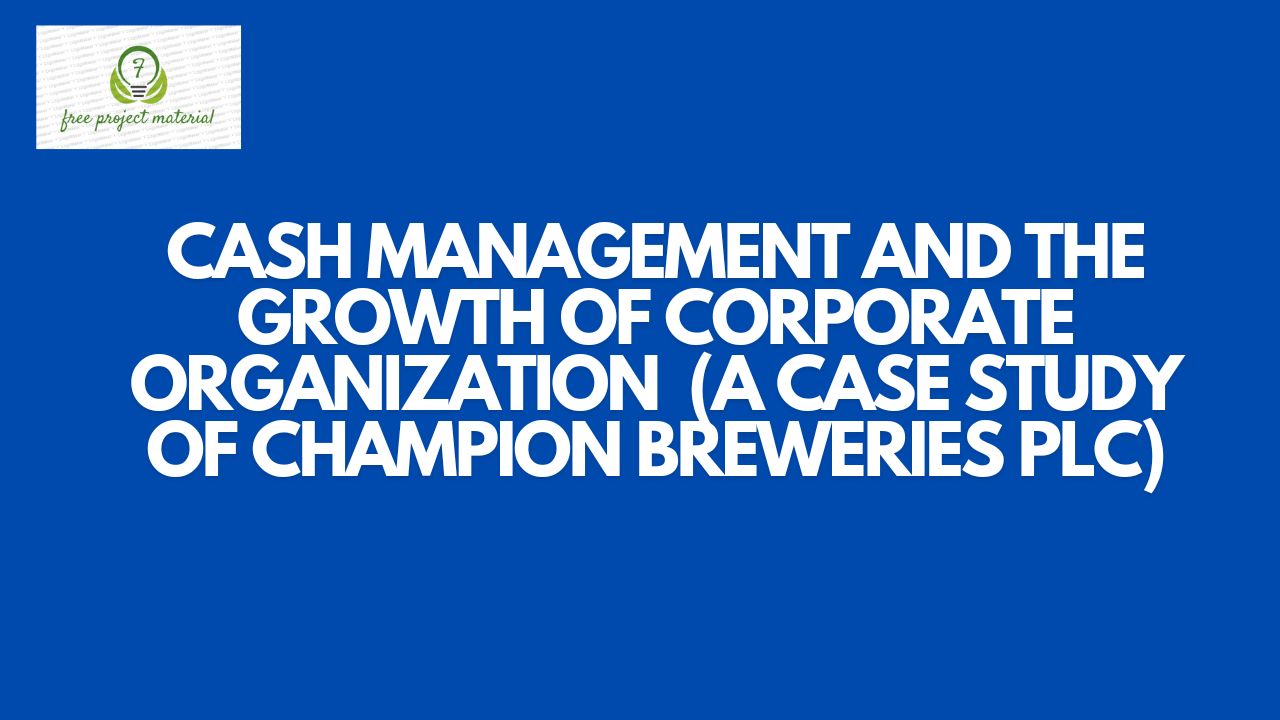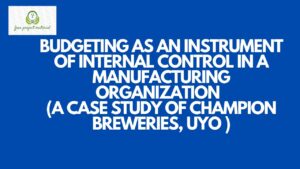ABSTRACT
This study is on cash management and the growth of corperate organisation (A case study of Champion Breweries Plc) This study investigated the impact of cash management on the growth of cooperate organisation of the listed company in Nigeria, A survey and ex post facto research designs were adopted for the study, judgemental samples techniques was used for the study, Taro Yamane’s techniques was used to select the samples size of 27 for the study, the study use secondary and primary sources of data, simple regression analysis were used to test the hypothesis of the study, findings from the study indicated that there is a significant effect of cash and it’s equivalent on the total assets of growth of Champion Breweries Plc. It was concluded in the study that cash management is crucial for growing corporate organization. It was recommended that cooperate organisation should develop and implement strategies to identify, access, and mitigate financial risks that may impact cash flow and subsequently safeguard health and support long-term growth objectives.
TABLE OF CONTENTS
Cover page – – – – – – – – – i
Fly leaf
Declaration – – – – – – – – – ii
Certification – – – – – – – – – iii
Dedication – – – – – – – – – iv
Acknowledgment – – – – – – – – v
Abstract – – – – – – – – – vi
List of Table – – – – – – – – – x
CHAPTER ONE
INTRODUCTION
1.1 Background of the Study – – – – – – 1
1.2 Statement of the Problem – – – – – – 3
1.3 Objectives of the Study – – – – – – 4
1.4 Research Questions – – – – – – – 5
1.5 Research Hypotheses – – – – – – – 5
1.6 Significance of the Study – – – – – – 5
1.7 Scope and Limitations of the Study – – – – – 6
1.8 Organization of the Study – – – – – – 6
1.9 Operational Definition of Key Terms – – – – – 7
CHAPTER TWO
REVIEW OF RELATED LITERATURE
2.1 Conceptual Review – – – – – – – 9
2.1.1 Overview of Cash Management – – – – – 9
2.1.2 Importance of Cash Management – – – – – 11
2.1.3 Factors Affecting Cash Management in Corporate Organization – 12
2.1.4 Challenges Faced by Corporate Organizations – – – 13
2.1.5 Effects of Cash Management on Financial Growth of
Corporate Organizations – – – – – – 13
2.1.6 Key Indicators in Cash Management – – – – – 14
2.1.7 Measures of Cash Management – – – – – 17
2.1.8 Overview of Organizational Growth – – – – – 23
2.1.9 Measures of Organizational Growth – – – – – 24
2.2 Theoretical Framework – – – – – – 31
2.2.1 Monetarist Theory of Cash Management – – – – 31
2.2.2 Operational Theory of Cash Management – – – – 31
2.2.3 Financial Theory of Cash Management – – – – 32
2.3 Review of Empirical Literature – – – – – 33
2.4 Summary of Related Literature – – – – – 37
2.5 Research Gap – – – – – – – – 38
CHAPTER THREE
METHODOLOGY
3.1 Design of the Study – – – – – – – 39
3.2 Area of the Study – – – – – – – 39
3.3 Population of the Study – – – – – – 39
3.4 Sample Size and Sampling Technique – – – – 39
3.5 Source and Nature of Data – – – – – – 40
3.6 Methods of Data Collection and Instrumentation – – – 40
3.7 Method of Data Analysis – – – – – – 41
3.8 Theoretical Specification of Model – – – – – 41
3.9 Empirical Specification of Model – – – – – 41
3.10 Ethical Issues – – – – – – – – 42
CHAPTER FOUR
DATA PRESENTATION, ANALYSIS AND DISCUSSION OF FINDINGS
4.1 Presentation of Data – – – – – – – 43
4.2 Analysis of Data – – – – – – – 47
4.3 Discussion of Findings – – – – – – 55
CHAPTER FIVE
SUMMARY, CONCLUSION AND RECOMMENDATIONS
5.1 Summary – – – – – – – – 57
5.2 Conclusion – – – – – – – – 57
5.3 Recommendations – – – – – – – 58
5.4 Implication of Findings – – – – – – 59
5.5 Contributions to Knowledge – – – – – – 59
5.6 Suggestions for Further Study – – – – – 60
REFERENCES
Appendices
LIST OF TABLES
Table 4.1.1: Questionnaire Administration – – – – 43
Table 4.1.2: Age Distribution of Respondents – – – – 44
Table 4.1.3: Gender Distribution of Respondents – – – – 44
Table 4.1.4: Marital Status of Respondents – – – – 45
Table 4.1.5: Educational Qualification of Respondents – – – 45
Table 4.1.6: Position held by Respondents – – – – – 46
Table 4.1.7: Working Experience of Respondents – – – – 46
Table 4.1.8: Table showing Cash and its Equivalence and Total Asset
Growth of Champion Breweries Plc., Uyo (2013 – 2022) – 47
Table 4.2.1.1: Response to Research Question One – – – – 48
Table 4.2.1.2: Response to Research Question Two – – – 49
Table 4.2.1.3: Response to Research Question Three – – – 50
Table 4.2.2.1: Variables in Two Decimal Places – – – – 51
Table 4.2.2.2: Relationship between Cash and Cash Equivalence and Total Asset
Growth of Champion Breweries Plc. (2013 – 2022) – – – 52
CHAPTER ONE
INTRODUCTION
1.1 Background of the Study
Cash is the most important asset for the operation of the business and the basic input needed to keep the business running on a continuous basis. It is also the ultimate output expected to be realized by seeing the services or product of a firm. The firm should keep sufficient cash, either more or less. Cash shortage will disrupt the firms operations while excessive cash will simply remain idle, without contributing anything towards the firms’ profitability. Thus, a major function of the financial manager is to maintain sound cash position for the firm. In order to manage a firm successfully, there must be reasonable attention paid to cash decision process of the firm, and keen monitoring process of the daily cash inflows and outflows (Adetifa, 2005).
Many corporate organizations have collapsed not because there is no enough cash at the initial stage, or qualified manager of finance that will handle the business but the simple thing that is lacking is the basic management of cash techniques. Inability to organize adequate control of cash has been the major cause of their failure to continue with their cash management proficiency. Some firms have mismanaged their cash resources by spending almost every cash valuable assets such as fixed assets, inventory receivable and deposit financial institutions. In order to maintain the effective running of the firms, all cash valuables assets must be properly managed (Randall & Farris, 2009).
Cash management decision concern every phases of organization operation where the flow of cash and the disbursement of cash in the organization is involved. A firm, which is principally concerned with the manufacturing and selling of its finished goods, has never been too burdened about the management of the firm’s cash. At the beginning of firms operation, there is supposed to be a critical cash management tactics employed to ensure a smooth running of the business (Olowe, 1998).
If however the company has an active sense of cash management, the need for additional cash would have occurred to those in charge to prevent liquidation. Preparation of cash flow statement that will clearly show cash inflows and outflows will seriously help in this situation. Management of funds is therefore more complex than its acquisition. For an owner of a business or a manager to manage cash or cash resources effectively, the knowledge of proper cash management must possessed so as to prevent insolvency which also end up in bankruptcy. Using cash budgeting, cash flows statement and optimum cash level determination, correct decision will be enhanced in an organization and profitable operations will be ascertained (CIMA, 2012).
Uwomda et al. (2013) stated that cash management decision is one of the most core and fundamental decisions in an organization because inadequate resources including finance in most financial institutions yet it is a requirement if they are to achieve their objectives. The elements of managing cash include planning, cash flow management, having optimum cash levels in place and surplus cash investment. Businesses need to strike a balance between liquidity and profitability while conducting daily operations. Firms need to make sure they meet their obligations in the short term and also meet their profitability goals. This is what is called liquidity. It is therefore important for companies to keep cash reserves in order to balance short term cash inflows and outflows. The management of cash focuses to ensuring adequate cash is maintained by the business entities and any surplus is put into the correct use (Uwonda et al., 2013).
Basically today, cash management has been significantly justified by the growing developments in the world of business over the years (Kesseven, 2006). These developmental strides include: changes in corporate banking relationship from buyer’s to a seller’s market, globalization of businesses which saw the creation of the Economic Monetary Union (EMU) in Europe, and the proposed adoption of a single currency in the West Africa region (Abioro, 2013); the emphasis on new treasury structures to better manage resources on a worldwide basis; the developing interest in e-commerce for business-to-business transactions which changes how data and funds flow greatly reduces working capital cycle time; the emergence of the “new economy” with its orientation to information and cash, driving finance into every area of a company (Marsh, 2009). Based on these developmental efforts, it becomes imperative that effective cash management is fundamental to business survival, growth and overall success.
1.2 Statement of the Problem
The process of managing cash has become a major challenge for most of the companies, because of its significant impact on the results of a company. The success of any business venture is predicted on how the management has planned and controlled its cash flow. Effective cash management is the fundamental standing point to ensure that the firm’s finances are in a strong position. Managing cash is a real challenge to financial managers in Nigeria; most companies obtain cash from inappropriate sources which creates problems in cash management, therefore bringing mismatch in investments decisions. The goals of cash management function brings out the basic flows and the cash position of a company, while maintaining its liquidity. Poor management practices constraints business operations and some customers who are not satisfied with the services ran away signifying poor performance and hence retards the business growth.
The problem arises in trying to encourage managers to spend money wisely as opposed to investing in projects with a lower required rate of return or wasting the said funds in organizational inefficiencies. When a company is holding cash or cash equivalents that are insufficient, interruptions of normal flow of most business operations which caused difficulties in meeting company liabilities such as payment of suppliers, staff wages and salaries and meeting deadlines for tax payments. However, inadequate cash management has led to slow rate in making orders, delivery of services timely due to delayed payment of suppliers. These inadequate or improper cash management procedures were some of the major challenges.
1.3 Objectives of the Study
The main objective was to examine cash management and the growth of corporate organization
The following specific objectives are to be achieved in this study:
(i) To determine the effect of cash and cash equivalents on total assets growth of Champion Breweries Plc.
(ii) To examine the effect of deposit on total asset growth of Champion Breweries Plc.
(iii) To assess the effect of cash reserves on total asset growth of Champion Breweries Plc.
1.4 Research Questions
The following questions were formulated to guide in the actualization of the above objectives.
(i) What is the effect of cash and cash equivalent on total asset growth of Champion Breweries Plc.?
(ii) What is the effect of deposit on total asset growth of Champion Breweries Plc.?
(iii) What is the effect of cash reserves on total asset growth of Champion Breweries Plc.?
1.5 Research Hypotheses
The following hypothesis are stated in null form.
: There is no significant correlation of cash conversion cycle on the growth of corporate organizations in Nigeria.
: There is no significant correlation of cash holding on the growth of corporate organizations in Nigeria.
H02: There is no significant correlation of cash holding on total asset growth of Champion Breweries Plc
1.6 Significance of the Study
This study will help to inform business owners and corporate organizations (Champion Breweries Plc. in particular) on the need for cash management and its relevance in the growth of business organization.
The study will also serves as a basis for decision making by firms, public stakeholders and corporate organization regarding cash management.
This study will help to x-ray the challenges affecting cash management in Champion Breweries Plc. and other corporate organizations so as to enable them to take necessary precautions.
1.7 Scope and Limitations of the Study
This study focused on cash management and the growth of corporate organization (A case study of Champion Breweries Plc).
The research encountered some constraints which limit the scope of this study such as:
Reluctant attitude of respondents to give answers to the questions on the questionnaire.
Time: The time strain did not allow wider coverage. This was occasioned by the researcher having to combine the research and other academic activities.
Financial Constraint: Insufficient funds impinged on the extensive sourcing of materials, literature information and in the process of data collection via internet, questionnaire and interview.
1.8 Organization of the Study
This study is organized into five chapters. Chapter One is the information and consisted of background of the study, statement of the problem, objectives of the study, research questions, research hypothesis, significance of the study, scope and limitations of the study, organization of the study and finally, operational definition of key terms. Chapter Two was the review of related literature. Chapter three is the methodology adopted in the research, nature of data collection and method of collection. Chapter Four was the data analysis of results computed by the researcher. Chapter Five was findings, conclusion and recommendations followed by implication of the findings, contribution to knowledge and suggestion for this study.
1.9 Operational Definition of Key Concepts
Cash and Cash Equivalents (CCE): Cash and cash equivalents are short-term, highly liquid assets held by a company that can be quickly converted into cash. It typically includes physical currency, bank deposits, and highly liquid investments with original maturities of three months or less.
Cash Management: This refers to the strategic handling and control of an organization’s cash resources. It involves monitoring, optimizing, and maintaining an appropriate level of cash to meet financial obligations while also seeking opportunities to invest surplus funds effectively.
Cash Reserve: A cash reserve refers to a portion of an organization’s funds set aside to cover unexpected expenses, emergencies, or to ensure liquidity. It serves as a financial buffer, helping a company meet its short-term financial obligations and mitigate financial risks.
Corporate Organization: A corporate organization refers to a legal entity formed by individuals or groups for the purpose of conducting business activities. It typically has a distinct legal status, with shareholders, a board of directors, and officers, and is responsible for its own obligations and liabilities separate from its owners.
Deposit: A deposit is a sum of money placed with a bank or financial institution for safekeeping or to earn interest.
Growth: This refers to the process of getting bigger, increasing, or developing over time. Essentially, it involves positive change and progress, leading to a larger, more advanced, or improved state compared to a previous point in time.



